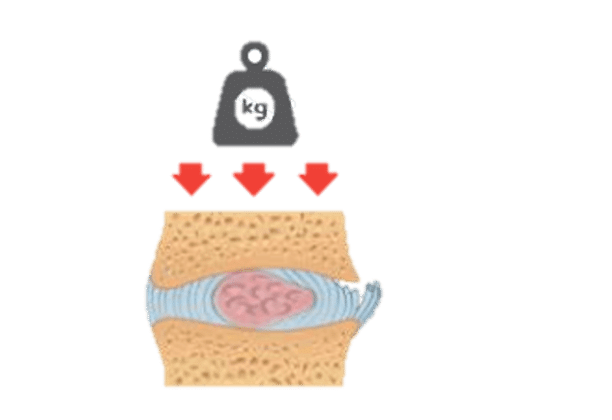Request Appointment
Enter your details and we will be in touch with you shortly;
Or call
8655885566
between 8 am and 8 pm.

Pain in upper back muscles that is often accompanied by neck , shoulder, and arm pain

Pain in the upper back is felt in the thoracic spine, which is from the base of the neck to the lower part of the rib cage. Although it occurs less than lower back pain, it is just as likely to make life difficult. Generally, these conditions are described as tightness, burning, or sharp pain, which worsens when you move or maintain one position for too long. Early recognition and upper back pain treatment are essential to prevent chronicity and restore mobility.
Thoracic pain can have several different sources:
The term ‘upper back pain’ applies to the thoracic spine, which consists of 12 vertebrae, from T1 to T12. It shields the ribs and helps safeguard the main organs. Some pain stays in one region of the body.
Targeted upper back pain therapy, including thoracic spine mobilization and upper back stretching, can relieve muscle tension and improve spinal alignment, offering effective upper back pain relief and supporting long‑term spinal health.
Upper back pain that occurs along with numbness or weakness in the arms can indicate a more serious problem and requires immediate medical attention. The symptoms of upper back pain may vary depending on the underlying condition. Upper back pain is usually described as aching, sharp, burning, and stiffness. The common upper back pain symptoms include:
Other conditions that can cause severe upper back pain that is worse at night and does not respond to 4 to 6 weeks of treatment will require investigation to diagnose if any infection or tumor is present.
 Professional diagnosis required
Professional diagnosis required Chronic, can last for years
Chronic, can last for years Treatable with 4 weeks of QI Spine Therapy
Treatable with 4 weeks of QI Spine TherapyIt is important to identify the underlying cause of your upper back pain so that the spine specialist can create a plan that will provide relief and strengthen your upper back muscles to facilitate long-term recovery.
Physicians call upper back pain as ‘thoracic spine pain’. The common causes of upper back pain are as follows:
Other disease conditions that may also contribute to upper back pain. Ex- fibromyalgia, scoliosis, kyphosis, and spinal deformity. If upper back pain worsens, it can affect everyday activities such as the ability to sit, throw a ball, the ability to carry heavy items, or even rest.
Slouching over time while seated or standing can stretch or damage the area around your upper back. This is one of the leading causes requiring upper back pain relief treatment to address chronic discomfort.
When you don’t exercise regularly, the muscles of your back become weaker, leading to less support for your spine. Over time, this leads to stiffness and increases the need for upper back pain therapy to regain flexibility and strength.
Repetitive motions or lifting heavy objects without proper technique can result in muscle strain, making upper back muscle strain treatment essential for recovery.
A significant body weight causes stress on your spine,, resulting in upper back discomfort. How you manage your weight plays a key role in finding lasting comfort from back pain.
Tightness in the upper back, which comes from emotional stress, can lead to uncomfortable muscle tension. Muscle tension relief strategies, such as relaxation techniques, can help mitigate this risk.
Conditions like scoliosis, arthritis, or herniated discs can increase susceptibility to upper back pain, necessitating specialized care and thoracic spine therapy for symptom management.
Regular upper back stretching and an ergonomic lifestyle are vital to mitigate these risks. Early intervention through effective upper back pain treatment can significantly improve quality of life.
You can lower your risk of troublesome upper back pain by making easy and regular changes to your lifestyle. They support good spine health, correct posture and help everyone stay physically healthy.
Keep your body upright while sitting, standing, or using smartphones or tablets. By slouching, you make your upper back work harder without realizing it. Practicing postural correction exercises helps build awareness and improve spinal alignment.
Taking part in regular exercise improves the health of your back muscles and spine. If you want an easy workout, try walking, swimming, or yoga. Daily movement is crucial for long-term upper back pain relief.
Provide support for your body by fixing your workstation for good posture. Choose chairs that adjust to your needs, position your screens correctly and don’t keep your neck bent for an extended time. It helps to ease stress on the back muscles.
Incorporate upper back stretching exercises into your routine, especially if you sit for long hours. Stretching makes your body more flexible and aids circulation which reduces muscle discomfort.
When you’re stressed, your upper back muscles get tense and tight. Breathing exercises, meditation, and relaxation techniques promote muscle tension relief.
Whenever you have to move a heavy thing, rely on your legs, not your back. Avoid turning your arms or back when lifting; hold the load close to yourself so you don’t hurt yourself.
 Professional diagnosis required
Professional diagnosis required Chronic, can last for years
Chronic, can last for years Treatable with 4 weeks of QI Spine Therapy
Treatable with 4 weeks of QI Spine TherapyThere are various approaches for upper back pain treatment. Upper back pain symptoms can be quite painful and uncomfortable. The most important thing about back pain is an accurate and timely diagnosis. Once that’s done:
Every back pain case is different, and so is the treatment for it. If left untreated, it can get worse over time. It is best that you consult a spine specialist as soon as pain symptoms appear.
The first step is to identify the postures and activities that should not be done, and pain management by specific medical movements that will work on reducing the pain.
Activities based on a detailed ergonomic analysis will be done to determine what changes should be made. Based on DSA reports, specific weak musculature is worked upon by isolating specific muscles.
The spine specialist may also work with you to relieve the stiffness and help with mobilization. Muscle imbalances will be corrected. The following steps are in general followed: -
You must visit a spine specialist if you have any of the following symptoms: -
 Professional diagnosis required
Professional diagnosis required Chronic, can last for years
Chronic, can last for years Treatable with 4 weeks of QI Spine Therapy
Treatable with 4 weeks of QI Spine TherapyThe most important thing about back pain is an accurate and timely diagnosis. Once that’s done:
Every back pain case is different and so is the treatment for it. If left untreated it can get worse over time. It is best you consult a spine specialist as soon as pain symptoms appear.
 Professional diagnosis required
Professional diagnosis required Chronic, can last for years
Chronic, can last for years Treatable with 4 weeks of QI Spine Therapy
Treatable with 4 weeks of QI Spine TherapyAccurate and timely diagnosis of upper back pain is essential for proper treatment. It is slightly difficult to find the exact cause of upper back pain as the source of your pain could be related to any of the spine components like vertebrae, discs, muscles, and ligaments.
Your spine specialist or physician shall go through your medical history and ask about your pain intensity, nature of work, physical activities, and symptoms. Nerve studies may also be conducted.
You will be checked for upper back pain during movements like sitting, bending, walking, or standing. If needed, you may be asked to undergo blood tests and imaging tests such as: -
At QI Spine, the diagnosis is made by understanding first the patient’s history, conducting a thorough physical examination, and doing a DSA (Digital Spine Analysis test), which helps analyze the root cause of the problem. It is a non-invasive functional test that helps in measuring spine function. Its controlled and guided movements help determine the spine's mobility, strength, and imbalances of muscles around the spine.
CT scans, MRIs, and X-rays often fail to pinpoint the exact source of pain, whereas DSA directly analyzes muscle tissue to identify the root cause. Here is how DSA is conducted & its benefits:
 Professional diagnosis required
Professional diagnosis required Chronic, can last for years
Chronic, can last for years Treatable with 4 weeks of QI Spine Therapy
Treatable with 4 weeks of QI Spine Therapy


Have a question?
Ask our spine specialists
Who is a QI Spine Specialist?
A QI Spine Specialist is a medical expert with

Dr. Nidhi Sanghvi Shah

Dr. Shital Gaikwad

Dr. Richa Bhatia
9000 hours
of specialisation in treating back and neck conditions
32 hours
of spine physiotherapy specialisation methods in McKenzie concepts, Kinetic control, Neurodynamic solutions, Mulligan’s concepts
500 hours
and 6 months of QI Spine specialisation courses
If your upper back pain is severe, does not go away or happens with numbness, weakness or difficulty breathing, you should worry. Around 20% of those with chronic upper back pain could have a hidden medical problem that ought to be addressed. Seeking upper back pain treatment promptly is essential in such cases.
You may relieve tension in your upper back with some stretches, heat from a pack or light massage. Upper back stretching or yoga can improve flexibility and reduce stress effectively. If the pain persists, consider seeking upper back pain therapy under the guidance of a professional.
In many cases, upper back pain can be caused by trapped gas which sends pain signals to the back from the digestive organs. Less than 1 in 10 people with digestive problems say they experience this distress. Trying to eat well and exercising more make the pain from gas less severe.
Upper back pain after sleeping is also known as Morning back pain. Sometimes, you may feel pain in your neck, shoulders, or a headache which is mainly due to awkward sleeping positions that irritate your back.
Most times, upper back pain is the result of poor posture and strain in the back. The common causes of upper back pain are awkward sleeping positions, bad mattress, improper lifting technique, carrying a heavy load, poor posture, muscle overuse, and accident. Certain disease conditions may be other reasons for upper back pain.
Take it easy to start with and rest for a while. You may use over-the-counter pain medications for instant pain relief. Alternatively, you may use an ice pack, heat therapy, massage therapy, and specific exercises to alleviate severe upper back pain.
Your doctor will go through your medical history, do a physical exam, and if needed, you may be asked to get a few imaging tests like x-ray, CT scan, MRI scan, DSA, etc.
DSA stands for digital spine analysis. It is a precise test that measures the strength, mobility, and balance of all the elements of the spine’s muscular components. It assists in providing the best upper back pain treatment.
Lack of exercise, stressful posture, obesity, smoking, and stress are some of the common risk factors for developing upper back pain.
You can take some easy steps to avoid upper back pain such as:
You may be able to resolve upper back pain problems by exercising regularly. Your spine specialist might advise you on certain exercises that can help in relieving your upper back pain.
Generally, upper back pain isn’t a cause of worry but it is surely uncomfortable, painful, and uneasy. If your upper back pain symptoms are severe and worsen progressively, you must seek immediate medical care.